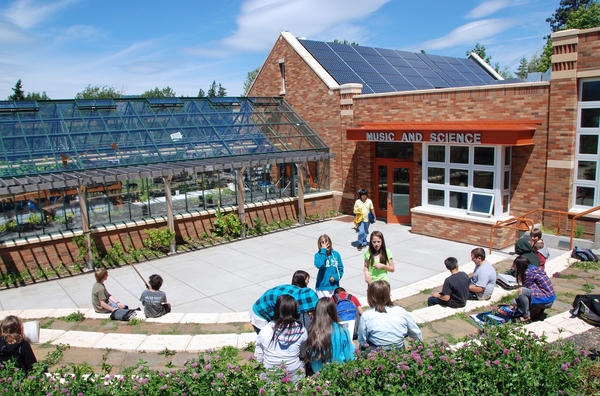By Joel Nelson on November 5, 2018 in Energy News

It was a different era in 1997, when Portland, Ore.-based New Buildings Institute, a nonprofit organization that promotes energy performance improvements in commercial buildings, was founded. LEED and ENERGY STAR® buildings, Living Buildings, market adoption of renewable energy to any measurable degree—all were yet to come.
“Reducing energy use was almost exclusively driven by utility efficiency programs focusing largely on fluorescent lighting upgrades,” NBI reflected recently. Today, At least 50% of customers have the option to purchase renewable electricity directly from their power supplier according to the U.S. Department of Energy.
Energy conservation has become considerably more sophisticated in a report NBI recently released to coincide with the organization’s 20th anniversary. While still small in relation to total buildings and floor space, zero building development in the U.S. is accelerating, according to the report.
Zero energy buildings—defined by the U.S. Department of Energy as a property or community where “on a source energy basis, the actual annual delivered energy is less than or equal to the on-site renewable exported energy”—are gaining favor across virtually all property types.
The recent NBI report, “Getting to Zero Status Update and List of Zero Energy Projects,” highlights nearly 500 zero energy commercial building projects across the U.S. Projects owned by for-profit companies account for 26% of the list. Privately held buildings account for 46% of zero energy buildings, with K-12 schools representing 18%. By contrast, NBI’s first Getting to Zero Status Update in 2012 reported just 60 commercial and multifamily buildings or projects that were either verified as zero energy or approaching that level.
Zero energy buildings had the potential to grow in popularity, Greg Zimmerman, executive editor of FacilitiesNet, said in 2010, because they are “the embodiment of sustainability because net-zero is a model that is self-contained—no outside resources are required and the model can therefore be sustained ad infinitum.” Furthermore, with green buildings becoming more common, a net-zero energy approach “will be a powerful method of market differentiation,” as well as “an essential element of any strategy to address climate change.”
The highest growth in new projects is in residential. A 2016 survey identified more than 8,000 housing units in the U.S. and Canada, a third more than the previous year, with the number of projects increasing by 82%. “Given the increasing number and power of market and policy drivers pushing for more [zero energy] homes, this growth will likely continue in the coming years,” the NBI report says. The report quotes Gene Myers, CEO of Denver-based Thrive Home Builders: “Zero energy has done more to define our brand than any other strategy we have used. Various programs that incrementally reduce energy consumption lack the impact of zero energy. We call it the Power of Zero.”
A key step in that progress was the evolution of enabling technology. In 2010, Nadav Malin, president and CEO of building design and construction consultant BuildingGreen, said, “Achieving a net-zero building with today’s technologies and occupant expectations is hard,” with any aspiring net zero building having to “first achieve significant load reductions and system efficiencies, and then meet the remaining loads with onsite energy generation.”
Since then, a multitude of factors converged to push zero energy buildings, including improved energy storage capabilities, better energy tracking capabilities, growing climate concerns, expanding private sector involvement and government policies favoring zero energy achievement. The progress to date and the projects examined in the report “are proof positive that zero energy design and operation is feasible in every climate, market sector, size, and building type across U.S. and Canada.”
Building designers and maintenance employees know that it’s easier to reduce a building’s energy consumption than to buy an equivalent amount of renewables. This is where building management software comes in, relieving human facilities employees from the overwhelming, if not impossible, task of keeping tabs on the multitude of internal and factors influencing a building’s energy consumption. For example, intelligent building energy management systems can create an automated, interconnected environment that actively optimize energy consumption and create meaningful analytics and alerts through fault detection and diagnostics systems. Artificial intelligence applications identify energy use baselines upon which future actions can be predicted.
DoE says, “Achieving zero energy is an ambitious yet increasingly achievable goal that is gaining momentum across geographic regions and markets. Private commercial property owners have a growing interest in developing zero energy buildings to meet their corporate goals, and in response to regulatory mandates, federal government agencies and many state and local governments are beginning to move toward zero energy building targets.”
Willpower is perhaps the most important energy in achieving this goal. As Malin noted, “It’s not all about technology and design. No matter how cleverly they are built, we won’t have net-zero buildings or communities unless we change the way that we live and work in them. That’s a challenge that we’re all facing together.”
Learn how an intelligent energy optimization solution from Yardi helped LBA Realty achieve annual savings of over 4 million kWh at a Class A office space campus.
Read NBI’s “Getting to Zero Status Update and List of Zero Energy Projects” report.


